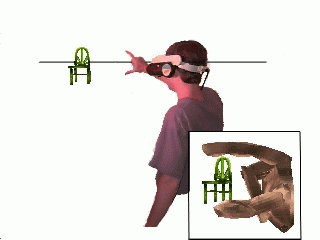|
Graphical user interfaces (GUIs) have been largely responsible for the commercial success of desktop applications and have allowed expert users as well as novices, even preschoolers, to be effective computer users. In fact, the graphical user interface is as important in making users productive as the application's functionality and performance.
Through steady improvements in hardware as well as in graphics algorithms, three-dimensional (3D) computer graphics is rapidly changing from an esoteric and expensive specialty to a commodity, just as 2D graphics did when Apple released the Macintosh in 1984. 3D graphics has already become an essential tool in both science and industry for analysis, design, production, and exploration, as well as in the latest video games. Nonetheless, 2D GUIs (often called the WIMP interface, for windows, icons, menus, and pointing) are still dominant even for 3D applications. We believe that new user-interface technology, such as the Center's pioneering 3D widgets [CONN92], can be far more productive for 3D applications than WIMP GUIs. Our long-term goal is to make user interaction with computer-based objects at least as easy as interaction with comparable real-world objects, particularly for familiar tasks. The strategy for achieving this goal is threefold:
* Focus on building interfaces for tasks in which speed of interaction is the essential feature of the real-world phenomenon (e.g., sketching designs on paper).
* Take advantage of the user's previously learned skills and experiences (e.g., ability to express ideas symbolically through graphical and gestural idioms such as architectural floor plans and hand waving).
* Evaluate our interfaces by studying the performance of users familiar with complex end-to-end tasks in an application area. We study the complex interrelationships among composite interaction techniques applied to real-world, non-trivial tasks.
Center interaction research involves collaboration among multiple sites and with other universities. The Center's efforts have influenced commercial products (e.g., Silicon Graphics' Open Inventor and Caligari's True Space) and have created 3D interface tools now used in the University of Utah's SCIRun system [PARK95] and at NASA.
Interaction Bibliography
|



 Sketch - Foundation Project
Sketch - Foundation Project  Sketch - Two-Handed Input
Sketch - Two-Handed Input  NPR (Non-Photorealistic Rendering)
NPR (Non-Photorealistic Rendering)  Interactive Illustrations
Interactive Illustrations  Smart Board
Smart Board  3D Widgets
3D Widgets  Projective Manipulation
Projective Manipulation  Lego Toolkit
Lego Toolkit  Haptics
Haptics  Responsive Workbench
Responsive Workbench  Head and Hand Tracking - HiBall
Head and Hand Tracking - HiBall  See-Through Video HMD
See-Through Video HMD Immersive VR Usability Studies
Immersive VR Usability Studies